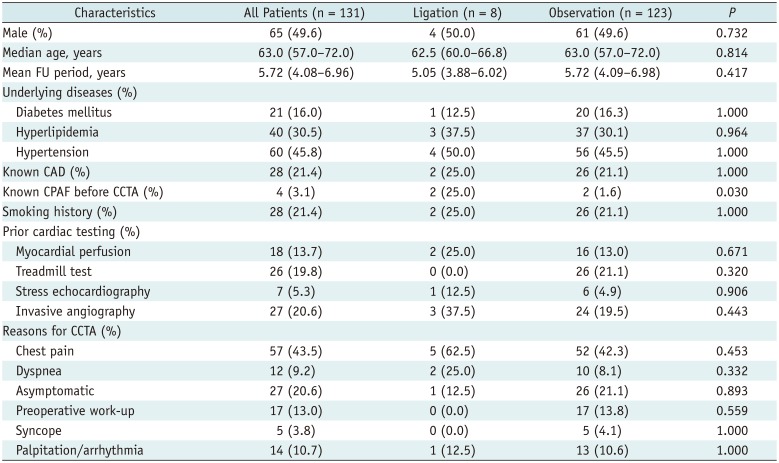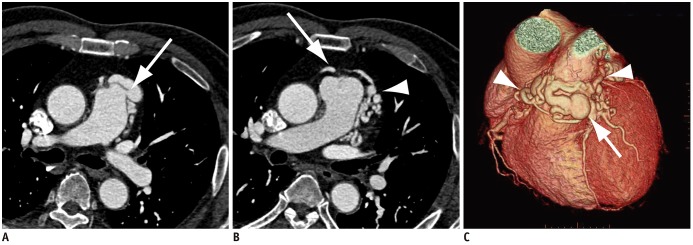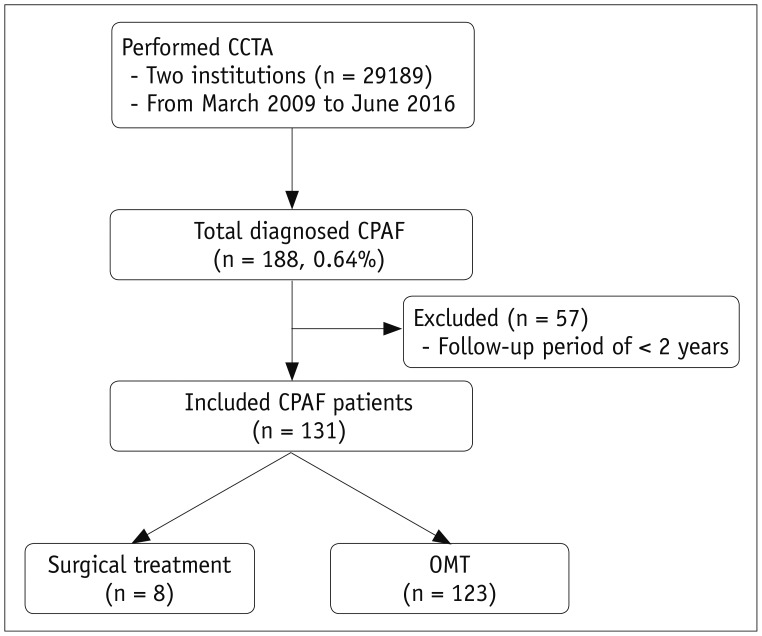1. Yildiz A, Okcun B, Peker T, Arslan C, Olcay A, Bulent Vatan M. Prevalence of coronary artery anomalies in 12,457 adult patients who underwent coronary angiography. Clin Cardiol. 2010; 33:E60–E64.

2. Yun H, Zeng MS, Yang S, Jin H, Yang X. Congenital coronary artery fistulas: dual-source CT findings from consecutive 6,624 patients with suspected or confirmed coronary artery disease. Chin Med J (Engl). 2011; 124:4172–4177. PMID:
22340382.
3. Lim JJ, Jung JI, Lee BY, Lee HG. Prevalence and types of coronary artery fistulas detected with coronary CT angiography. AJR Am J Roentgenol. 2014; 203:W237–W243. PMID:
25148179.

4. Zhang LJ, Zhou CS, Wang Y, Jin Z, Yu W, Zhang Z, et al. Prevalence and types of coronary to pulmonary artery fistula in a Chinese population at dual-source CT coronary angiography. Acta Radiol. 2014; 55:1031–1039. PMID:
24280135.

5. Bae JS, Park EA, Lim J, Lee W, Park JH. Multi-detector CT coronary angiographic findings of coronary-to-pulmonary artery fistula. J Korean Soc Radiol. 2017; 76:39–47.

6. Verdini D, Vargas D, Kuo A, Ghoshhajra B, Kim P, Murillo H, et al. Coronary-pulmonary artery fistulas: a systematic review. J Thorac Imaging. 2016; 31:380–390. PMID:
27768631.
7. Lee CM, Song SY, Jeon SC, Park CK, Choi YW, Lee Y. Characteristics of coronary artery to pulmonary artery fistula on coronary computed tomography angiography. J Comput Assist Tomogr. 2016; 40:398–401. PMID:
26854415.

8. Kim MS, Jung JI, Chun HJ. Coronary to pulmonary artery fistula: morphologic features at multidetector CT. Int J Cardiovasc Imaging. 2010; 26(Suppl 2):273–280.

9. Umaña E, Massey CV, Painter JA. Myocardial ischemia secondary to a large coronary-pulmonary fistula--a case report. Angiology. 2002; 53:353–357. PMID:
12025925.
10. Papadopoulos DP, Perakis A, Votreas V, Anagnostopoulou S. Bilateral fistulas: a rare cause of chest pain. Case report with literature review. Hellenic J Cardiol. 2008; 49:111–113. PMID:
18459470.
11. Saito A, Ono M, Motomura N, Hirata Y, Morota T, Takamoto S. A surgical case of symptomatic coronary artery-pulmonary artery fistula. Asian Cardiovasc Thorac Ann. 2006; 14:e4–e5. PMID:
16432105.

12. Yang SW, Zhou YJ, Hu DY. Bilateral coronary artery fistula as a cause of angina pectoris. BMJ Case Rep. 2013; 4. 15. [Epub]. DOI:
10.1136/bcr-2013-008971.

13. Konopka A, Kumor M, Juraszyński Z, Kowalski M, Zagrodzka M, Stępińska J. Coronary artery fistula in a 70 year-old woman with myocardial infarction. Kardiol Pol. 2011; 69:940–941. PMID:
21928205.
14. Härle T, Kronberg K, Elsässer A. Coronary artery fistula with myocardial infarction due to steal syndrome. Clin Res Cardiol. 2012; 101:313–315. PMID:
22212517.

15. Palloshi A, Aprigliano G. Myocardial ischemia due to a large coronary-pulmonary fistula with plexus-like morphology. J Cardiovasc Med (Hagerstown). 2008; 9:1163–1165. PMID:
18852595.

16. Vijayvergiya R, Bhadauria PS, Jeevan H, Mittal BR, Grover A. Myocardial ischemia secondary to dual coronary artery fistulas draining into main pulmonary artery. Int J Cardiol. 2010; 140:e30–e33. PMID:
19135267.

17. Kawano M, Wada T, Anai H, Shuto T, Miyamoto S. A case of ruptured aneurysm of coronary-pulmonary artery fistula diagnosed after emergency thoracotomy. Surg Case Rep. 2018; 4:24. PMID:
29572614.

18. Said SA. Congenital coronary artery fistulas complicated with pulmonary hypertension: analysis of 211 cases. World J Cardiol. 2016; 8:596–605. PMID:
27847561.

19. Goto Y, Abe T, Sekine S, Iijima K, Kondoh K, Sakurada T. Surgical treatment of the coronary artery to pulmonary artery fistulas in adults. Cardiology. 1998; 89:252–256. PMID:
9643271.

20. Ata Y, Turk T, Bicer M, Yalcin M, Ata F, Yavuz S. Coronary arteriovenous fistulas in the adults: natural history and management strategies. J Cardiothorac Surg. 2009; 4:62. PMID:
19891792.

21. Lee Y, Naruse Y, Tanaka K. Surgical treatment of coronary to pulmonary artery fistulas in adults. Int Heart J. 2017; 58:1012–1016. PMID:
29151493.

22. Cherian M, Poyyamoli S, Mehta P. Endovascular management of a coronary artery to pulmonary artery fistula with detachable balloons: a case report. Cardiovasc Diagn Ther. 2018; 8:399–402. PMID:
30057886.

23. Avcı A, Aytürk M, Güner A, Çiçek MB, Kargın R. Case image: treatment of a fistula between coronary and pulmonary arteries with simultaneous use of two microcatheters for antegrade coil embolization. Turk Kardiyol Dern Ars. 2018; 46:737. PMID:
30516536.
24. Lee SK, Jung JI, O JH, Kim HW, Youn HJ. Coronary-to-pulmonary artery fistula in adults: evaluation with thallium-201 myocardial perfusion SPECT. PLoS One. 2017; 12:e0189269. PMID:
29216309.

25. Challoumas D, Pericleous A, Dimitrakaki IA, Danelatos C, Dimitrakakis G. Coronary arteriovenous fistulae: a review. Int J Angiol. 2014; 23:1–10. PMID:
24940026.

26. Saboo SS, Juan YH, Khandelwal A, George E, Steigner ML, Landzberg M, et al. MDCT of congenital coronary artery fistulas. AJR Am J Roentgenol. 2014; 203:W244–W252. PMID:
25148180.

27. Demirbag R. Coronary arteriovenous fistula. In : Branislav B, editor. Coronary angiography: the need for improvement in medical and interventional therapy. Rijeka: InTech;2011. p. 165–188.
28. Budnur SC, Singh B, Jayaranganath M. Percutaneous transcatheter device closure of coronary arteriovenous fistula through persistent left superior vena cava. J Invasive Cardiol. 2013; 25:E24–E26. PMID:
23388233.
29. Ghaffari S, Akbarzadeh F, Pourafkari L. Aneurysmal coronary arteriovenous fistula closing with covered stent deployment: a case report and review of literature. Cardiol J. 2011; 18:556–559. PMID:
21947993.

30. Gowda RM, Vasavada BC, Khan IA. Coronary artery fistulas: clinical and therapeutic considerations. Int J Cardiol. 2006; 107:7–10. PMID:
16125261.

31. Lim WH, Kang SH, Jeon K, Cho I, Kim KH, Hwang SW, et al. Asymptomatic right coronary artery-to-pulmonary artery fistula incidentally detected by transthoracic echocardiography. J Cardiovasc Ultrasound. 2009; 17:106–109. PMID:
20661326.

32. Stout KK, Daniels CJ, Aboulhosn JA, Bozkurt B, Broberg CS, Colman JM, et al. 2018 AHA/ACC guideline for the management of adults with congenital heart disease: executive summary: a report of the American College of Cardiology/American Heart Association task force on clinical practice guidelines. Circulation. 2019; 139:e637–e697. PMID:
30586768.

33. Said SM, Burkhart HM, Schaff HV, Connolly HM, Phillips SD, Suri RM, et al. Late outcome of repair of congenital coronary artery fistulas--a word of caution. J Thorac Cardiovasc Surg. 2013; 145:455–460. PMID:
23218710.

34. Qureshi SA. Coronary arterial fistulas. Orphanet J Rare Dis. 2006; 1:51. PMID:
17184545.

35. Takeuchi N, Takada M, Nishibori Y, Maruyama T. A case report of coronary arteriovenous fistulas with an unruptured coronary artery aneurysm successfully treated by surgery. Case Rep Cardiol. 2012; 2012:314685. PMID:
24826243.

36. Thakkar B, Patel N, Poptani V, Madan T, Saluja T, Shukla A, et al. Clinical and angiographic follow-up of coronary artery fistula interventions in children: techniques and classification revisited. Cardiol Young. 2015; 25:670–680. PMID:
24775405.









 PDF
PDF ePub
ePub Citation
Citation Print
Print




 XML Download
XML Download